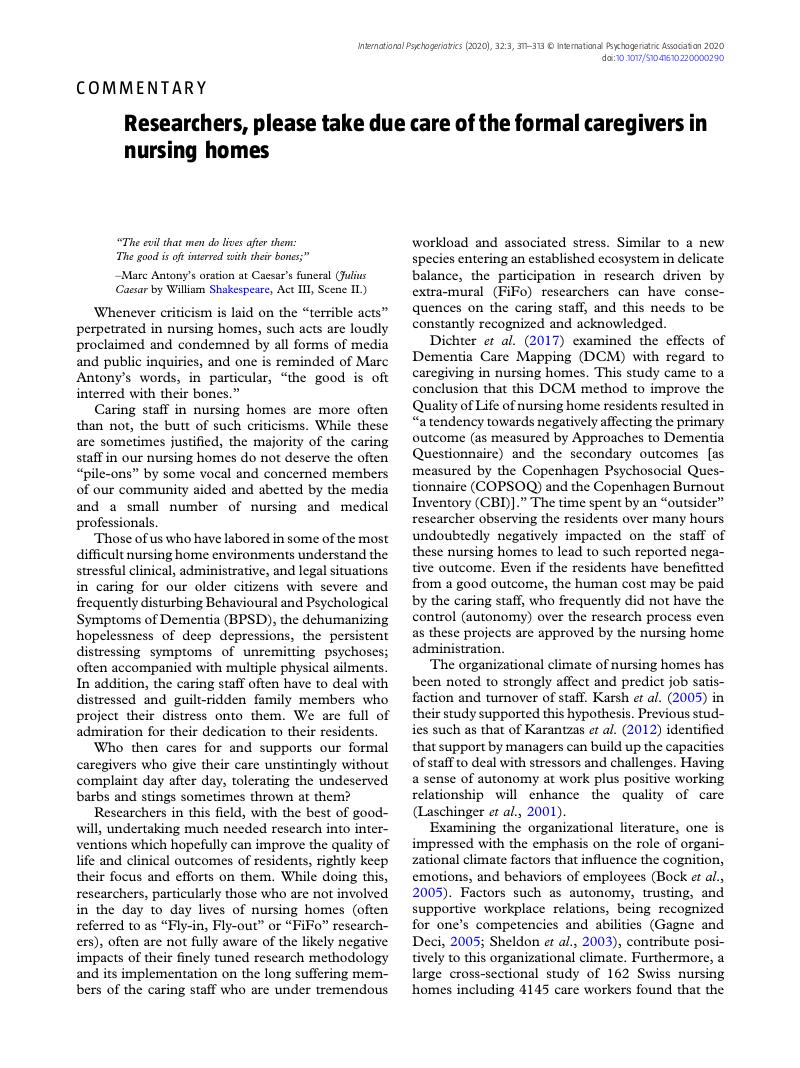No CrossRef data available.
Article contents
Researchers, please take due care of the formal caregivers in nursing homes
Published online by Cambridge University Press: 20 March 2020
Abstract
An abstract is not available for this content so a preview has been provided. Please use the Get access link above for information on how to access this content.

- Type
- Commentary
- Information
- International Psychogeriatrics , Volume 32 , Issue 3: Issue Theme: Improving Healthcare in Long-Term Care and Nursing Homes , March 2020 , pp. 311 - 313
- Copyright
- © International Psychogeriatric Association 2020
References
Australian Government – Department of Health. (2018). A Matter of Care – Australia’s Aged Care Workforce Strategy, Aged Care Workforce Strategy Taskforce. Available at https://www.health.gov.au/sites/default/files/a-matter-of-care-australia-s-aged-care-workforce-strategy.pdf.Google Scholar
Bock, G. W., Zmud, R. W., Kim, Y. G. and Lee, J. N. (2005). Behavioral intention formation in knowledge sharing: Examining the roles of extrinsic motivators, social-psychological forces, and organisational climate. MIS Quarterly, 29, 87–111. doi: 10.2307/25148669.CrossRefGoogle Scholar
Clarke, D, Jones, F, Harris, R, Robert, G and on behalf of the Collaborative Rehabilitation Environments in Acute Stroke (CREATE) team. (2017). What outcomes are associated with developing and implementing co-produced interventions in acute healthcare settings? A rapid evidence synthesis. BMJ Open, 7, e014650. doi: 10.1136/bmjopen-2016-014650.CrossRefGoogle ScholarPubMed
Dichter, M. N.et al (2017). Dementia care mapping in nursing homes: effects on caregiver attitudes, job satisfaction, and burnout. A quasi-experimental trial. International Psychogeriatrics, 29, 1993–2006. doi: 10.1017/S104161021700148X.CrossRefGoogle ScholarPubMed
Gagne, M. and Deci, E. L. (2005). Self-determination theory and work motivation. Journal of Organizational Behavior, 26, 331–362. doi: 10.1002/job.322.CrossRefGoogle Scholar
Karantzas, G. C., Mellor, D., McCabe, M. P., Davison, T. E., Beaton, P. and Mrkic, D. (2012). Intention to quit work among care staff working in the aged care sector. The Gerontologist, 52, 506–516. doi: 10.1093/geront/gnr161.CrossRefGoogle ScholarPubMed
Karsh, B., Booske, B. C. and Sainfort, F. (2005). Job and organisational determinants of nursing home employee commitment, job satisfaction and intent to turnover. Ergonomics, 48, 1260–1281. doi: 10.1080/00140130500197195.CrossRefGoogle Scholar
Laschinger, H. K. S., Shamian, J. and Thomson, D. (2001). Impact of magnet hospital characteristics on nurses’ perception of trust, burnout, quality of care, and work satisfaction. Nursing Economics, 19, 209–219.Google Scholar
Leontjevas, R., Hooijschuur, L., Smalbrugge, M., Koopmans, R. and Gerritsen, D. (2020). Specific components of a complex depression care program can affect staff outcomes differently: post-hoc analyses of a stepped-wedge cluster-randomized trial in nursing homes. International Psychogeriatrics, 32, 371–380. doi: 10.1017/S1041610219002151.CrossRefGoogle ScholarPubMed
McCabe, M. P., Mellor, D., Karantzas, G., Von Treuer, K., Davison, T. E. and O’Connor, D. (2017). Organisational factors related to the confidence of workers in working with residents with dementia or depression in aged care facilities. Aging and Mental Health, 21, 487–493. doi: 10.1080/13607863.2015.1118011.CrossRefGoogle ScholarPubMed
Ryan, R. M. and Deci, E. L. (2000). Self-determination theory and the facilitation of intrinsic motivation, social development, and well-being. American Psychologist, 55, 68–78. doi: 10.1037//0003-066X.55.1.68.CrossRefGoogle ScholarPubMed
Schwendimann, R., Dhaini, S., Ausserhofer, D., Engber, S. and Zuniga, F. (2016). Factors associated with high job satisfaction among care workers in Swiss nursing homes – a cross-sectional survey study. BMC Nursing, 15, 37. https://doi.org/10.1186/s12912-016-0160-8.CrossRefGoogle ScholarPubMed
Shakespeare, W., George, A. J., Black, E. C. and Hudson, H. N. (2009). The New Hudson Shakespeare: Julius Caesar [electronic resource]. Project Gutenberg: 28334, Project Gutenberg. Available at http://www.gutenberg.org/files/28334/28334-h/28334-h.htmGoogle Scholar
Sheldon, K. M., Turban, D. B., Brown, K. G., Barrick, M. R. and Judge, T. A. (2003). Applying self-determination theory to organisational research. Research in Personnel and Human Resources Management, 22, 357–394. doi: 10.1016/S0742-7301(03)22008-9.Google Scholar
Velasquez Reyes, D.et al. (2019). Behavioural activation in nursing homes to treat depression (BAN-Dep): study protocol for a pragmatic randomised controlled trial. BMJ Open, 9, e032421. doi: 10.1136/bmjopen-2019-032421.CrossRefGoogle ScholarPubMed
Williams, B., Perillo, S. and Brown, T. (2015). What are the factors of organisational culture in health care settings that act as barriers to the implementation of evidence based practice? A scoping review. Nurse Education Today, 35, 34–41. doi: 10.1016/j.nedt.2014.11.012.CrossRefGoogle ScholarPubMed




